

The Suwannee County, Florida paleontological sites are assemblages of Early Miocene invertebrates and vertebrates occurring in Suwannee County, Florida.


The Suwannee County, Florida paleontological sites are assemblages of Early Miocene invertebrates and vertebrates occurring in Suwannee County, Florida.
Era : Neogene
Period : Early Miocene
Faunal stage : Arikareean (30.8—20.6 Ma.), calculates to a period of approximately 1.2 million years.
S1BA site aka Live Oak site. AEO: ~21.8—21.7 Mya., approximately 0.1 million years [1]
Coordinates: 30°18′N83°00′W / 30.3°N 83.0°W

The Mustelidae are a family of carnivorous mammals, including weasels, badgers, otters, ferrets, martens, minks and wolverines, among others. Mustelids are a diverse group and form the largest family in the order Carnivora, suborder Caniformia. They comprise about 66–70 species across nine subfamilies.
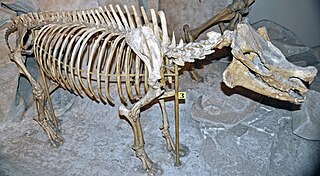
Menoceras is a genus of extinct, small rhinoceros endemic to most of southern North America and ranged as far south as Panama during the early Miocene epoch. It lived from around 30.7—19.7 Ma, existing for approximately 11 million years.

Ekorus ekakeran is a large, extinct mustelid mammal. Fossils, including largely complete skeletons, are known from the late Miocene of Kenya.
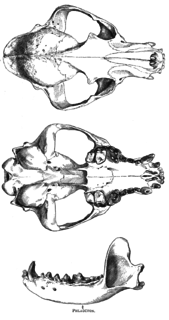
Phlaocyon is an extinct genus of the Borophaginae subfamily of canids native to North America. It lives from the Early Oligocene to the Early Miocene epoch 33.3–16.3 Mya, existing for approximately 17.3 million years. It is closely related to Cynarctoides.

Hesperocyon is an extinct genus of canids that was endemic to North America, ranging from southern Canada to Colorado. It appeared during the Uintan age–Bridgerian age (NALMA) of the Mid-Eocene 42.5 mya—31.0 Ma. (AEO). Hesperocyon existed for approximately 11.5 million years.

Daphoenus is an extinct genus of bear dogs. Daphoenus inhabited North America from the Middle Eocene to the Middle Miocene, 37.2—16.0 Mya, existing for approximately 21 million years.

Osbornodon is an extinct genus of canid that were endemic to North America and which lived from the Oligocene to the Early Miocene, 33.9—15.97 Ma (AEO), existing for approximately 18 million years. It was the last surviving genus of the hesperocyonine subfamily, the oldest subfamily of canids.

Tomarctus is a canid genus of the extinct subfamily Borophaginae which inhabited most of North America during the late Early Miocene to the Early Barstovian age of the Middle Miocene. Tomarctus existed for approximately 6.83 million years.
The cat gap is a period in the fossil record of approximately 18.5 million to 25 million years ago in which there are few fossils of cats or cat-like species found in North America. The cause of the "cat gap" is disputed, but it may have been caused by changes in the climate, changes in the habitat and environmental ecosystem, the increasingly hypercarnivorous trend of the cats, volcanic activity, evolutionary changes in dental morphology of the Canidae species present in North America, or a periodicity of extinctions called van der Hammen cycles.

The Torreya Formation is a Miocene geologic formation with an outcrop in North Florida. It is within the Hawthorn Group.

The Leon County paleontological sites are assemblages of Early Miocene invertebrates and vertebrates of Leon County, Florida, United States.

The Gadsden County paleontological sites are assemblages of Early Miocene invertebrates and vertebrates occurring in Gadsden County, Florida, United States.

The Jefferson County, Florida paleontological sites are assemblages of Mid-Miocene to Late Pleistocene vertebrates from Jefferson County, Florida, United States.

The Choctaw Sea was a Cenozoic eutropical subsea, which along with the Okeechobean Sea, occupied the eastern Gulf of Mexico basin system bounding Florida.

The Okeechobean Sea was a Cenozoic eutropical subsea, which along with the Choctaw Sea, occupied the eastern Gulf of Mexico basin system bounding Florida.
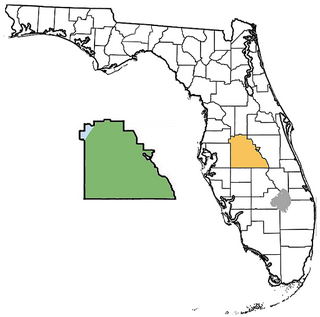
The Polk County paleontological sites are assemblages of Early Miocene to Late Pleistocene vertebrates occurring in Polk County, Florida, United States.
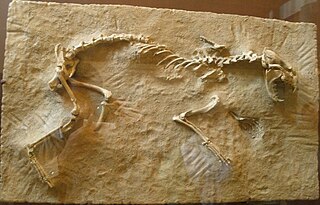
Sthenictis is an extinct genus in the weasel family (mustelids) endemic to North America and Asia during the Miocene epoch living from ~15.97—5.33 Ma (AEO) existing for approximately 11 million years.
Trigonictis macrodon is an extinct species of mammal related to the living grison (genus Galictis). It lived in North America during the Pliocene to Pleistocene epochs, from ~4.1–1.6 Ma. (AEO), existing for approximately 2.5 million years. Fossil specimens have been found across the United States, from Washington and Oregon in the northwest to California and Florida in the south.
Enhydritherium terraenovae is an extinct marine otter endemic to North America that lived during the Miocene through Pliocene epochs from ~9.1–4.9 Ma. (AEO), existing for approximately 4.2 million years.
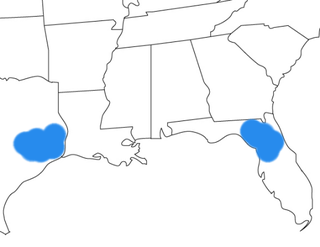
Floridachoerus olseni is an extinct peccary that lived during the Hemingfordian age of the Early Miocene, and was endemic to North America. F. olseni was in existence for approximately 4.46 million years. Remains of this extinct mammal were located at the fossil rich Thomas Farm site in Gilchrist County, Florida and Toledo Bend site, Newton County, Texas. Floridachoerus olseni was named after Stanley. J. Olsen of the Florida Geological Survey in 1962. Olsen previously worked at the site for Harvard University.